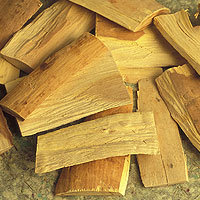Sandalwood
Uses
Parts Used & Where Grown
Sandalwood trees grow in India and other parts of Asia. The wood is renowned for carving and also yields the volatile oil used in herbal medicine.
Our proprietary “Star-Rating” system was developed to help you easily understand the amount of scientific support behind each supplement in relation to a specific health condition. While there is no way to predict whether a vitamin, mineral, or herb will successfully treat or prevent associated health conditions, our unique ratings tell you how well these supplements are understood by the medical community, and whether studies have found them to be effective for other people.
For over a decade, our team has combed through thousands of research articles published in reputable journals. To help you make educated decisions, and to better understand controversial or confusing supplements, our medical experts have digested the science into these three easy-to-follow ratings. We hope this provides you with a helpful resource to make informed decisions towards your health and well-being.
3 StarsReliable and relatively consistent scientific data showing a substantial health benefit.
2 StarsContradictory, insufficient, or preliminary studies suggesting a health benefit or minimal health benefit.
1 StarFor an herb, supported by traditional use but minimal or no scientific evidence. For a supplement, little scientific support.
This supplement has been used in connection with the following health conditions:
| Used for | Why |
|---|---|
1 Star Infection Refer to label instructions | Sandalwood is an herb that directly attack microbes. Herbs that directly attack microbes include the following: chaparral, eucalyptus, garlic, green tea, lemon balm (antiviral), lomatium, myrrh, olive leaf, onion, oregano, pau d’arco (antifungal), rosemary, sage, , St. John’s wort, tea tree oil, thyme, and usnea. |
Traditional Use (May Not Be Supported by Scientific Studies)
Sandalwood oil was used traditionally by herbalists to treat skin diseases, acne, dysentery, gonorrhea, and a number of other conditions.1 In Traditional Chinese Medicine, sandalwood oil is considered an excellent sedating agent.
How It Works
The volatile oil contains high amounts of alpha- and beta-santalol. According to a test tube study, these small molecules possess antibacterial properties.2 This makes it a potential topical treatment for skin infections. Synthetic sandalwood oil does not contain these active ingredients. Internal use of sandalwood is approved by the German Commission E for the supportive treatment of infections of the lower urinary tract (usually the urinary bladder).3 However, clinical trials are lacking to support this use.
How to Use It
The German Commission E monograph suggests 1/4 teaspoon (1–1.5 grams) of the volatile oil for the supportive treatment of urinary tract infections.4 This should only be done under the supervision of a doctor. Treatment should not exceed six weeks. For external use, a few drops of sandalwood oil are dissolved in 6 ounces (180 ml) of water and applied directly to the infected area of skin several times daily.
Interactions with Supplements, Foods, & Other Compounds
Interactions with Medicines
Side Effects
Some people may experience mild skin irritation from topical application of sandalwood oil.5 People with kidney disease should not use sandalwood internally. Until more is known, sandalwood oil should be avoided for internal use during pregnancy and breast-feeding. Infants and children should not take sandalwood oil internally.
1. Duke JA. CRC Handbook of Medicinal Herbs. Boca Raton, FL: CRC Press, 1985, 426-7.
2. Okazai K, Oshima S. Antibacterial activity of higher plants. XXIV. Antimicrobial effect of essential oils (5). J Pharm Soc Japan 1953;73:344-7.
3. Blumenthal M, Busse WR, Goldberg A, et al. (eds). The Complete Commission E Monographs: Therapeutic Guide to Herbal Medicines. Boston, MA: Integrative Medicine Communications, 1998, 199.
4. Blumenthal M, Busse WR, Goldberg A, et al. (eds). The Complete Commission E Monographs: Therapeutic Guide to Herbal Medicines. Boston, MA: Integrative Medicine Communications, 1998, 199.
5. Blumenthal M, Busse WR, Goldberg A, et al. (eds). The Complete Commission E Monographs: Therapeutic Guide to Herbal Medicines. Boston, MA: Integrative Medicine Communications, 1998, 199.
Last Review: 03-24-2015

Copyright © 2024 TraceGains, Inc. All rights reserved.
Learn more about TraceGains, the company.
The information presented by TraceGains is for informational purposes only. It is based on scientific studies (human, animal, or in vitro), clinical experience, or traditional usage as cited in each article. The results reported may not necessarily occur in all individuals. For many of the conditions discussed, treatment with prescription or over the counter medication is also available. Consult your doctor, practitioner, and/or pharmacist for any health problem and before using any supplements or before making any changes in prescribed medications. Information expires December 2024.
This information does not replace the advice of a doctor. Ignite Healthwise, LLC, disclaims any warranty or liability for your use of this information. Your use of this information means that you agree to the Terms of Use. Learn how we develop our content.

